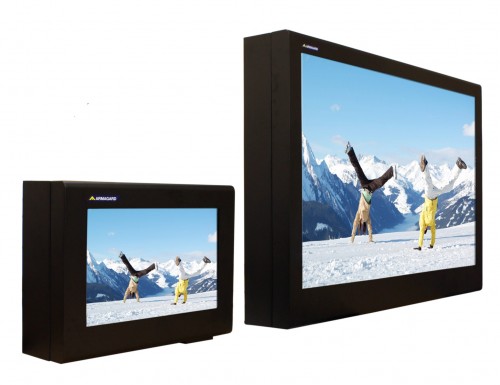Outdoor Digital Signage – An Overview – Part One
Posted by: Richard Williams | Posted on: | 0 Comments
Digital signage has become a common sight. Many businesses now use this flexible and dynamic medium to advertise, promote and raise brand awareness, and its use has penetrated both the indoor and outdoor advertising sectors.
However, indoor signage screens and outdoor digital signage are two separate entities and there is very little in the way of cross-over between the two.
Yes, both use either LCD or plasma displays out of home, but this is where the similarities between indoor digital signage and outdoor systems, differ.
Content and screen type that may work well in an indoor environment may not be suitable for outdoor digital signage and vice versa. Indoor displays, for instance, are designed for certain light conditions, temperature. Whilst an outdoor screen needs to be water proof, rugged and able to operate in various weather types and temperature.
The Challenges
The challenges that uniquely face outdoor digital signage and have to be countered before any screen is placed outside are:
- Brightness
- Weather
- Temperature
- Vandalism
- Time
Brightness
The biggest enemy of an outdoor sign is the sun. The sun’s brightness can counteract the brightness of the screen so the outdoor digital signage becomes faded and difficult to read. For this reason, any screen placed in an outdoor location has to be high brightness. Normally, with standard LCD screens the backlight will produce somewhere in the region of 500-800 candela, but an outdoor screen can go much brighter: 1200-2000 candela.
But the problems caused by the sun don’t stop there. The sun can cause glare, reflecting off the screen making it unreadable. To counter this, anti-glare glass can be used but this will diminish the brightness of the TV. Another solution for outdoor TVs is to place them away from the sun or in a canopy, thus preventing glare. This is not always practical so a combination of high brightness screen and anti-reflective glass are used.
Weather
The most obvious challenge with placing a screen in an outdoor location is the weather. Rainfall is perhaps the common but an outdoor screen has to prevent all sorts of weather elements from damaging the screen. Snow, sleet and even airborne dust also have the potential to disable a screen so the digital signage enclosure or screen itself must be protected from the elements.
The two standards to watch out for when buying an outdoor TV or a protective LCD enclosure are the IP65 (in Europe) and (NEMA 4) in the USA. Hardware built to these standards should be protected from the weather – no matter what it throws at the screen.
Continue reading in Part two.
Post shortlink:
Popular Products
LCD Enclosure
Need armor for your LCD/LED screen(s)? Outdoors or inside the versatile LCD enclosure protects against thieves, vandals & the weather. Installation idea: NFL stadiums.
Outdoor Digital Signage
Exclusive 46” outdoor screen protection. Dubbed the ‘Totem’, due to its distinct design, it repels damage threats, but attracts audiences. Installation idea: Drive-thru restaurants.
Portrait Flat Panel Enclosure
Safeguard your eye-level advertising display screen(s), indoors or outdoors. Completely customizable, add exciting features like touch screen technology. Installation idea: Restaurant frontages.
Indoor Digital Signage
Popular purchase for retail outlets! Great for ‘point of sale’ persuasion, boost your brand with static & motion advertising from a single unit! Installation idea: Mall of America.





